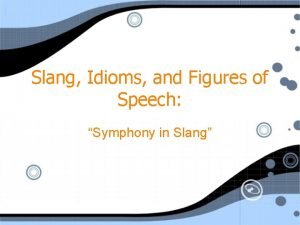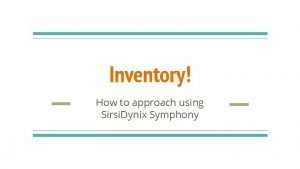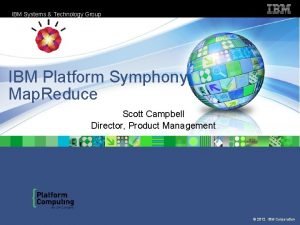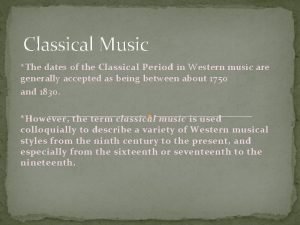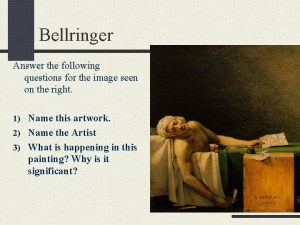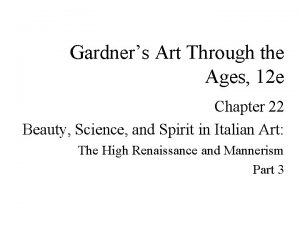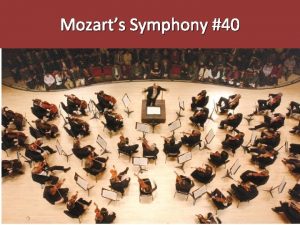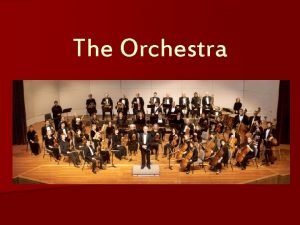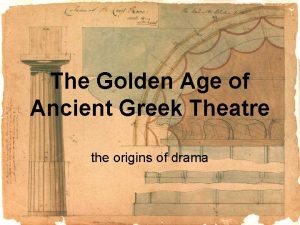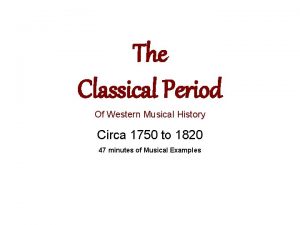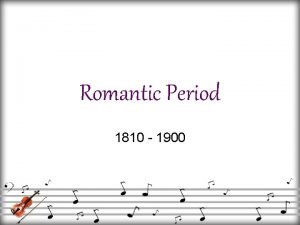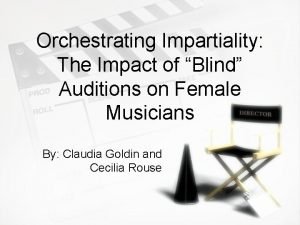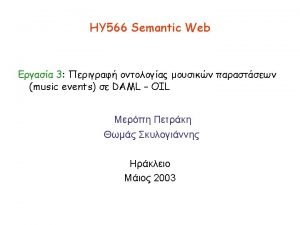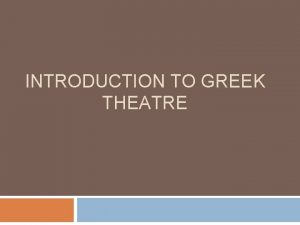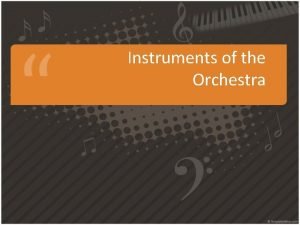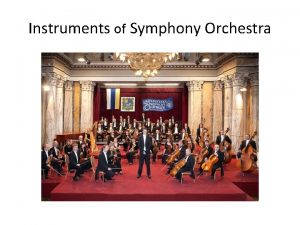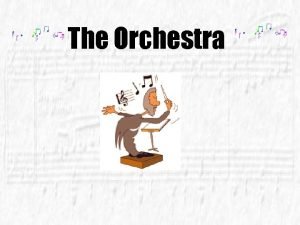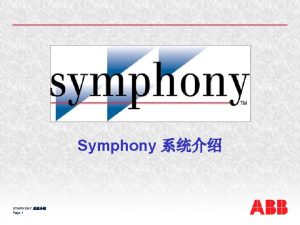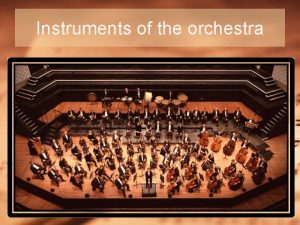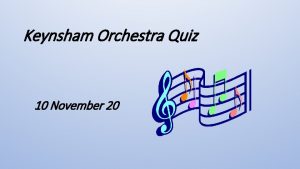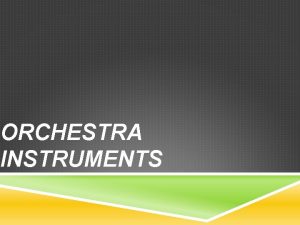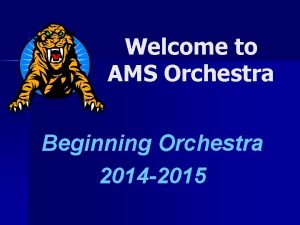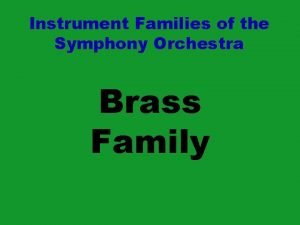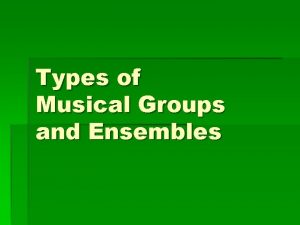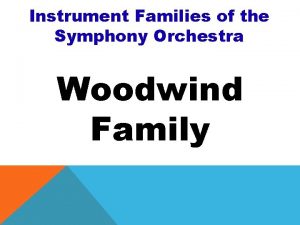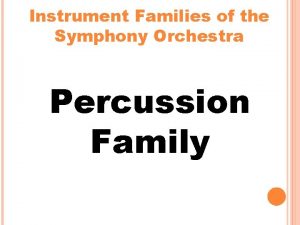The Symphony Orchestra An Introduction Symphony Goes to




























- Slides: 28

The Symphony Orchestra: An Introduction Symphony Goes to School. . . and Beyond! Program NSO Education Program Prepared by Timothy Brennan Copyright © NSO 2020

The Symphony Orchestra � � � Since the era of Ancient Greece, instrumentalists have come together to perform in both large and small groups. However, the modern symphony orchestra only came into existence within the last few hundred years. In fact, the word “orchestra” is a Greek word referring to the stage where the performers in a Greek play would stand. Perhaps this is why orchestras today perform on a stage! Alan Gilbert conducting the New York Philharmonic

Seating Plan of the Orchestra � � � The modern symphony orchestra consists of four main groups of instruments: strings, woodwinds, brass, and percussion. Each instrument has a specific place in the orchestra, as shown in the seating plan on the right. Since percussion and brass are the loudest instruments, they are placed at the back of the orchestra. Woodwinds and strings are in front.

String Instruments � � � The first group of instruments we will explore are the string instruments. String instruments have metal strings that produce sound when plucked or bowed using a bow (a long wooden rod with horse hair or synthetic hair that contacts the strings). These instruments have undergone many structural changes throughout history which have increased the range and possibilities for different timbres and sounds.

Violin � � The highest-pitched string instrument. The modern violin emerged in Italy in the early 16 th century. Many of the most famous early violin makers were Italian, notably Antonio Stradivari and the Guarneri family. It is the only instrument in the orchestra to be divided into two large sections (first and second violins). Click here to listen to an excerpt from Tchaikovsky’s Violin Concerto performed by famous violinist Joshua Bell, violinist

Viola � � The viola is similar to the violin but it has a deeper, mellower tone and a lower range. Music for the viola is written using the alto clef. The viola often plays an accompaniment role in orchestral music, but occasionally is featured. There exists a body of solo repertoire for the viola. Click here to listen to violist Eivind Holtsmark Ringstad perform Henri Vieuxtemps’ Elegie. Eivind Holtsmark Ringstad, violist

Cello � � The full name of the cello is actually violoncello. Held between the knees, the cello has a wide spectrum of timbres and a large range. The cello has C, G, D, and A -strings, whereas the violin has G, D, A, and E-strings. Click here to watch famous cellist Seeli Toivio perform the first movement of Elgar’s Cello Concerto. Seeli Toivio, cellist

Double Bass � � Also referred to as the contrabass, the double bass is the lowest and largest instrument of the string instruments. The double bass plays the bass line in orchestral music and is sometimes a featured instrument. It is often associated with jazz music, but there exists much solo classical repertoire for the double bass. Click here to listen to bassist Roger Mc. Cann perform “Elephants” from Saint-Saëns’ Carnival of the Animals. Roger Mc. Cann, bassist

� � � Harp The harp is the only string instrument that is not bowed. It is played by plucking the strings. The harp originated with the ancient Greek lyre: an early plucked string instrument. Often characterized by its angelic and heavenly sound. The modern concert pedal harp was created in the late 17 th century with more pedals added in the 19 th century. Click here to listen to young Russian harpist Alisa Sadikova perform Marcel Grandjay’s The Fountain. Alisa Sadikova, harpist

Woodwind Instruments � � � The next group of instruments we will explore are the woodwind instruments. Woodwind instruments generally produce sound when air is blown through the instrument and vibrates a wooden reed made of cane. Modern wind instruments date back to the Middle Ages (ca. 1400’s) and have evolved into the instruments we know today.

Flute � � The earliest flutes were made in pre -historic times. Early humans made animal bone flutes that date back to around 43, 000 BCE! The modern flute (or transverse flute) was first used in the 17 th century and made of wood. Today, flutes are generally made of metal. The flute the only woodwind instrument that does not use a reed. Instead, sound is produced when air is blown across an embouchure hole at one end of the instrument. Click here to watch famous flautist Emmanuel Pahud perform Debussy’s Syrinx. Emmanuel Pahud, flautist

The Flute Family There exist variants of the flute that are used regularly in orchestral music. Click on the instrument names below to listen to these instruments. Piccolo A smaller flute-like instrument with a high range Alto flute A larger and mellower flute

� � Oboe The oboe is a double reed instrument, meaning that the reed consists of two pieces of cane instead of one. The oboe’s predecessor was a medieval instrument called the shawm. The modern oboe first appeared in the mid- 17 th century. The sound of an oboe is characterized as more nasal than other woodwind instruments, but also lush and romantic. Click here to watch oboist Henrik Chaim Goldschmidt perform Ennio Morricone's "Gabriel's Oboe" (from his score to the film The Mission). Pavel Sokolov, oboist

English Horn � � � The English horn is a larger, deeper, and mellower double reed instrument related to the oboe. When used in orchestral works it is often highlighted in solos. Click here to listen to the well-known English horn solo from the 2 nd movement of Dvorak’s Symphony No. 9 (“From the New World”). English horn

Clarinet � � � The clarinet is a single reed instrument as the reed consists of one piece of cane. The modern clarinet developed from the Baroque instrument called the chalumeau. The clarinet was introduced into the orchestra in the early Classical period with composers like Stamitz and Mozart favouring the clarinet’s vocallike timbre. It has the largest range of the woodwind instruments. Click here to listen to well-known clarinetist Sabine Meyer perform Strauss’s Romance for Clarinet and Orchestra. Sabine Meyer, clarinetist

The Clarinet Family Most clarinet students begin by learning to play the Bflat clarinet. However, there are other common clarinets used regularly in orchestral music. Click on the instrument names below to hear these instruments. E-flat clarinet Higher-pitched and smaller than the B-flat clarinet Bass clarinet Low-pitched, large, and mellow clarinet

Bassoon � � The bassoon is a double reed instrument like the oboe, but has a lower range and deeper sound. In the Baroque era (17 th to mid 18 th centuries), the bassoon mainly provided accompaniment in orchestral music. In the Classical era (mid 18 th to early 19 th centuries) with composers like Mozart and Beethoven, the bassoon was given more prominence as a solo instrument. Click here to listen to bassoonist Voltan Aligi perform the first movement from Mozart’s Bassoon Concerto. Michael Parkinson, bassonist

Contrabassoon � � � The contrabassoon is a larger bassoon that sounds an octave lower. Does not usually appear as a solo instrument and is mainly used in orchestral music for specific tone and colour effects. Click here to listen to a contrabassoon.

Brass Instruments � � � The third family of instruments we will explore are the brass instruments. Brass instruments are made of brass metal and produce sound through a combination of the vibration of air blown through the instrument and the vibration of the player’s lips on a mouthpiece. Brass instruments are characterized as celebratory with their full and loud sounds, and are often used in the military and for royal celebrations.

Trumpet � � � The highest pitched brass instrument. Trumpets have existed since ca. 1500 BCE! The early concert trumpets had no valves and the player controlled the pitch using only their lips. Valves were added to the trumpet in the 19 th century, expanding the range and technical capabilities of the instrument. Click here to listen to famous trumpeter Alison Balsom perform the first movement from Haydn’s Trumpet Concerto. Alison Balsom, trumpeter

Trombone � � � The trombone is a mid-range brass instrument that uses a slide to vary the pitch. The early trombones of the Medieval and Renaissance eras (ca. 900 AD – 1600 AD) were called sackbuts. The trombone was occasionally used in orchestral music in the Baroque era (ca. 1600 -1750); however it was given more prominence beginning with the music of Beethoven. Its importance as a solo and orchestral instrument expanded greatly in the 19 th century. Click here to hear well-known trombonist Joseph Alessi (principal trombone of the NY Philharmonic) perform Arthur Pryor’s Air Varie. Joseph Alessi, trombonist

French Horn � � The french horn is a circular shaped brass instrument with a round, mellow tone. Early horns are called natural horns (valve-less horns) and were frequently associated with hunters and the outdoors. Valves were added to the horn in the early 19 th century, expanding the range and timbre of the instrument. Click here to listen to hornist David Pyatt perform the third movement of Richard Strauss’s First Horn Concerto. David Pyatt. hornist Radek Baborák, hornist

Tuba � � � The tuba is the largest brass instrument and has the lowest range. Various sizes of tubas exist from the tenor tuba to sub-contrabass tuba! Tubas are primarily associated with brass and military bands, but their prominence in orchestral music increased throughout the 19 th and early 20 th centuries. Many composers, including Ralph Vaughan Williams and Alexander Arutiunian, have written tuba concertos which showcase the tuba as a solo instrument. Click here to listen to tubist Øystein Baadsvik perfrom an arrangement of Monti’s Czardas. Øystein Baadsvik, tubist

Percussion Instruments � � The final family of orchestral instruments we will explore is the percussion family. Percussion instruments are extremely versatile in terms of how they make sound. For example, they can be struck with a beater (stick), scraped, rubbed, bowed, played with the hands, or hit against another instrument to name a few. Percussionists consider almost anything to be a percussion instrument, including junk yard trash! Standard orchestral percussion instruments are generally classified into two broad categories: pitched and non-pitched.

Pitched Percussion Click on the instrument names below to hear these instruments: Xylophone Timpani Vibraphone Marimba Celesta

Non-Pitched Percussion Click on the instrument names below to hear these instruments: Triangle Snare Drum Bass Drum Cymbals

Exit Activity � Now that you know about the instruments of the orchestra, click here to listen to Benjamin Britten’s A Young Person’s Guide to the Orchestra. � At each time stamp listed on the next slide, identify the instrument (or instrument family) that is playing or being featured.

Exit Activity (cont’d) 1. 0: 22 -0: 45 2. 0: 46 -1: 03 3. 1: 04 -1: 20 4. 1: 21 -1: 35 5. 1: 56 -2: 29 6. 2: 30 -3: 31 7. 3: 32 -4: 07 8. 4: 08 -5: 00 9. 5: 01 -5: 33 10. 5: 34 -6: 36 11. 6: 37 -7: 52 12. 7: 53 -8: 52 13. 8: 53 -9: 40 14. 9: 41 -10: 25 15. 10: 26 -10: 57 16. 10: 58 -11: 40 17. 11: 59 -12: 13 *For time stamps 18 -21, identify instruments in order of appearance 18. 12: 14 -13: 42 19. 13: 43 -14: 24 20. 14: 25 -15: 07 21. 15: 08 -15: 28 22. 15: 38 - end
 Vertical solutions
Vertical solutions Idioms are figures of speech
Idioms are figures of speech Beethoven symphony 5 rok
Beethoven symphony 5 rok Symphony inventory management
Symphony inventory management A symphony of whales comprehension questions
A symphony of whales comprehension questions Ibm symphony grid
Ibm symphony grid A symphony of whales read aloud
A symphony of whales read aloud What are the dates of the classical period
What are the dates of the classical period Symphony characteristics
Symphony characteristics The venus of urbino
The venus of urbino Do you _____ chocolate milk
Do you _____ chocolate milk Mozart symphony 40 instruments
Mozart symphony 40 instruments Controlled variable science
Controlled variable science Walter ruttmann
Walter ruttmann Color symphony experiment
Color symphony experiment What is orchestra
What is orchestra Tragos greek theatre definition
Tragos greek theatre definition Classical period orchestra
Classical period orchestra Romantic period characteristics
Romantic period characteristics Orchestrating impartiality
Orchestrating impartiality Orchestra conductor name
Orchestra conductor name Kiki zumach
Kiki zumach Orchestra,theatron,parados
Orchestra,theatron,parados Instrument families worksheet
Instrument families worksheet Theatron greek theatre definition
Theatron greek theatre definition Skene teatr grecki
Skene teatr grecki Maskers grieks theater
Maskers grieks theater What are the four families of the orchestra
What are the four families of the orchestra Types of orchestra
Types of orchestra

